Healing

After learning about Jesse Lewis, a six-year-old who died in the Sandy Hook shooting a year ago this Dec. 14th, I’m thinking about scratching out the name Jacob in Psalm 146 and writing in Jesse.
Psalm 146, verse 5 says, “Happy are those whose help is the God of Jacob, whose hope is in the LORD their God.” I’m wondering if scratching out Jacob and writing in Jesse, at least in these upcoming weeks, might be a way of praying to transform anger and resentment into love and forgiveness.
Jesse was a pretty amazing six-year old who loved adventures, mud, a golden yellow bear, and his big brother. His mom says he was “full of courage and strength,” so much so, that in the midst of the unfolding tragedy Jesse stood still and told his classmates to “Run!” In so doing, he lost his life.
Scarlett Lewis, Jesse’s mom, returned home after the unthinkable tragedy only to find something wonderful Jesse had scratched onto the kitchen chalkboard: "Norturing, helin, love." His mom knew immediately these were Jesse’s last words to her: Nurturing, healing, love. In her book, Nurturing Healing Love: A Mother’s Journey of Hope & Forgiveness, Scarlett tells the story of her journey to forgiveness and hope as a legacy beyond anger and resentment. She begins, of course, with Jesse’s story.
I CAN’T WRITE a completely unbiased, academic review of this book: Nora Gallagher is a friend, and I know the medical world that she must still navigate, and how wonderful it is when you arrive at the Mayo Clinic. This book is for anyone who plans to die one day and wants to live daily with purpose and with a real God. Those who are or have been physically ill will find a kindred soul in Gallagher, while the healthy will wonder how they will handle the sad, sympathetic gazes from others in the pew when their names are placed on the prayer list.
When she is 60, the vision in one of Gallagher’s eyes begins to fail. She limits the use of her one good eye for fear of losing sight in it too. Not so bad, you might think—except that as a writer, seeing is key to paying for the medical tests and travel she will endure for two years.
Of course all good patients become writers in a way. At first you take random notes in scattered notepads. Finally you redefine yourself as a full-time patient whose life demands documentation of every symptom and test in a little black book that becomes your constant companion. You have now entered what Gallagher calls Oz, the land of illness.
For Gallagher, Oz is strange. Oz is blurry. She is lonely. She is a patient not a person. Oz has many disrespectful, condescending doctors working in machine-like hospital systems that allow 10 minutes for a consult; they must get to the next patient, not solve the mystery of her now-painful, debilitating state.
Cleats and Dignity
The civil rights struggle for African Americans happened in every sphere of life. Breaking the Line: The Season in Black College Football That Transformed the Sport and Changed the Course of Civil Rights, by Samuel G. Freedman, tells of two great black coaches in the tense year of 1967. Simon & Schuster
Catching Fire
One project of the USC Center for Religion and Civic Culture is the Pentecostal and Charismatic Research Initiative, which funded research in more than 20 countries. PCRI resources include the informative recent report, “Moved by the Spirit: Pentecostal and Charismatic Christianity in the Global South.” crcc.usc.edu/pcri
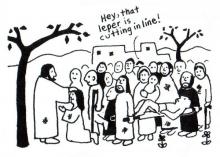
I have to say, one of my very favorite things about Jesus is how he does whatever he wants to and could really give a hell about how other people feel about it. Yeah. I just find that endearing — especially when he irritates the nice religious people. That’s secretly my favorite.
In our Gospel text for today Jesus is teaching in the synagogue on a Sabbath when he sees a woman with a crippled back. He saw her, called her over and said “Woman you are set free from your ailment.” He reached out and touched her and she stood upright for the first time in 18 years and praised God — which seems like a win. Except for that then the leader of the synagogue throws a little tizzy about how that kind of thing should not be happening on the Sabbath. Further proof that super religious people can just be so helpful, can’t they?
Especially when they seem to value parameters over people – which should sound like a familiar story …
Stories of churches denying your call to ministry because you fall outside the parameters of which gender is allowed to be ordained and stories of churches denying you the Eucharist because you fall outside the parameters of what kind of sexual orientation is allowed to receive the means of grace and stories of churches denying you a place in community because you just weren’t sure if you believed in God and that falls outside the parameters of doctrinal purity – well, these kind of stories are sadly bordering on cliché around here. We hear them all the time.

WHICH SCRIPTURES WILL our biases tempt us to sidestep this month? Perhaps 2 Timothy? Not usually the favorite of radicals. Whether actually written by Paul just before his death or worked up later by followers, the letter has a certain poignancy, suggesting the waning of Christianity’s pioneer phase. The church is in for the long haul. Its faith needs to find forms that can be transmitted across generations. It needs patient leadership that will be consistent in the face of inauthentic mutations of the gospel, religious imposters, and the distraction of futile controversies—hence the emphasis on sound teaching, the internalized treasure of the creed.
Let’s honor this recognition within scripture itself that the gospel needs institutions. The church must even risk banality in some of its teaching practices. A great interpreter of the Christian mystical tradition, Friedrich von Hügel, invites us to respect the way radical teachings have to be given forms that can be handled by regular folks, not geniuses. “Is there not a pathetic instruction in watching the insertion of the copper alloy into the pure gold ... that is, a metal sufficiently resistant to the clumsy handling of the multitude to be able to persist in the transmission of a value, and indeed a precise value, even though it be not the highest. There is surely a pathos here most thoroughly characteristic of the abiding limitations and homely needs of our poor humanity.”
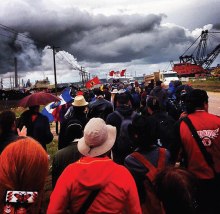
Environmental activist Bill McKibben took part in the July 5-6 Healing Walk, a spiritual gathering in northern Alberta, Canada, focused on the destruction—to the immediate environment and to the climate itself— caused by tar sands oil extraction and the Keystone XL pipeline across the U.S.
TO WALK, SLOWLY, across the tar sands complex of Alberta is to see our real-life equivalent of The Lord of the Rings’ Mordor. It really is as bad as everyone says. On this one eight-mile loop, we saw vast stretches of muskeg turned into dry, sandy desert; we saw dry-sandy desert that had been further converted into inky tailings lakes; and we were never out of earshot of the cannon that fire all day and all night to keep ducks from landing in the toxic waters. This goes on forever. The most comprehensive way to see it is from the air, I guess, but the best way to feel it is on foot.
Especially if you’re walking with the people who know this land best—have known it for thousands of years. Each year since 2010, local First Nations groups have organized a Healing Walk through the tar sands, and this year’s fourth iteration was by far the largest. Hundreds of people from around the continent camped for several days in a stretch of nearby boreal forest, held workshops and ceremonies, and then emerged for the hike through the industrial barrens.

A few years ago I wrote a book about the experience of watching 24 consecutive hours of bad Christian television. My friends and family signed up for an hour each to watch along with me. The whole thing was insane, but things got especially crazy around 1 a.m. when a show called the Power Team was on. Now, thePower Team are a bunch of enormous steroid-muscled men who hold really loud Christian rallies in which they tear phone books in two and break 2x4s over their heads by the power of the Holy Spirit. And they talk a lot about what “the Lord” had done for them. It’s impressive stuff.
Anyway, so our own Andie Lyons was watching with me along with my friend Jerry. And the three of us watched in stunned silence for a moment trying to understand what it was we were seeing, at which point Andie finally said “so wait, basically they break stuff for the Lord?” and I answered yes, and then Jerry said “big deal, I break stuff all the time,” to which Andie asked, “but is it for the Lord?” and Jerry said, “well, it is now!”
Honestly the only reason I told you this story is by way of saying that I’m not a fan of the over-use of the term “the Lord. ”Like when people say “I just love the Lord,” I just never really know what that means. The way it’s casually thrown around makes me uncomfortable especially after Harry Potter, since Voldemort is called the Dark Lord. I just, I don’t know, I’m not saying it’s wrong, I’m just saying that for whatever reason, I can’t handle it.

A movement of lay advocates speaking out against sexual violence is gaining steam in the faith communities. But are similar efforts happening inside church doors?
When it comes to leading denominational conversations on sexual violence, clergy across traditions express twin reactions: encouragement over the protocols already in place and the efforts of fellow advocates; and frustration with a culture of silence around sexual violence in the church. Despite strikingly different experiences across denominations — and church by church — the clergy, church staff, and seminarians who spoke with Sojourners are in agreement that addressing this issue in one’s own house is complicated at every level.
The result: a loss of potential by the American church to be a leading and vibrant institution of radical vulnerability and transformative healing.

AS THE SEAONS after Pentecost unfolds, we might think that summer calls for a kind of “church lite” in which we shouldn’t expect much to happen. With the dramatic commemorations behind us, the scriptures seem miscellaneous. But this season has its own purpose of soaking in the Word. Just let go of dependence on drama.
Our month’s reading opens in 2 Kings 5 with the healing of Naaman, the distinguished Aramean general, told with a dry humor that Jesus appreciated, since he specifically mentions it (Luke 4:27) in his teaching about faith found outside the bounds of Israel. At first Naaman’s dignity is offended by Elisha not bothering even to meet him in person. His pride receives a further blow in the ludicrous banality of the prescription that Elisha’s assistant passes on: “Go, and wash in the Jordan seven times” (verse 10). Naaman’s fuming about the short shrift he got, and the humiliation of being prescribed a business of splashing in a local stream, are quite comic. Paddling in the Jordan indeed—a ditch in comparison to the storied rivers of Damascus! Smiling, we recognize the storyteller’s shrewd knowledge of psychology. The tale has a good ending. Finally getting off his high horse, Naaman allows his aide to persuade him to try the simple bathing routine. Over time his skin is healed and rejuvenated.
The church behaves like that shrewd aide when it invites us to trust in the power of hearing the scriptures again and again, however overfamiliar some of them seem, and others obscure.
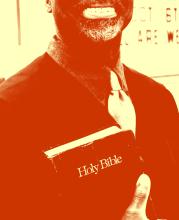
Most of us are too familiar with this story: an Upper Midwestern Baptist minister claims that “God made Christianity to have a masculine feel [and] ordained for the church a masculine ministry.” Or a Reformed Christian pastor mocks the appointment of the first female head of the Episcopal Church, comparing her to a “fluffy baby bunny rabbit.” Or a Southern Baptist megachurch pastor in California says physical abuse by one’s spouse is not a reason for divorce. Or numerous young evangelical ministers brag about their hot wives in tight leather pants.
Fewer of us are familiar with this story: Tamar is raped by her half-brother Amnon. Tamar protests her brother’s advances, citing the social code of Israel, his reputation, and her shame, to no avail. Their brother Absalom commands her to keep quiet, and their father, the great King David, turns a blind eye.
What do these contemporary statements above, delivered into cultural megaphones with conviction and certainty, have to do with the Old Testament rape and silencing of Tamar? The difficult answer is, quite a lot. The narrative dominance of these stories rests on power and control, which — whether intentional or not — speaks volumes about whom the church serves and what the church values.
FOR SERIOUS AND chronic mental illness, there is no cure—short of a miracle. There is no “all better.” Even when well managed, such illness is a lifelong reality, and relapses can happen without warning. Even for episodic illness, the road to health can be long and mountainous. Walking alongside someone with mental illness may mean a lifelong hike over peaks and valleys, learning to grow in faith and in relationship with Jesus through an illness that clouds the view. That walk might cause mistrust of reality and of a person’s own thoughts. It might require extra patience for processing truth. It might repeatedly tax the resources of the church and its fellowship. And churches, like other organizations, grow tired of such taxation. Culturally, we expect people who fall down to pull themselves back up and put their hands to the plow. Sure, everyone stumbles occasionally. And we’re willing to give help in times of crisis. But when that time of crisis doesn’t seem to end, we start to wonder why we’re still helping. Why we’re not seeing progress. Why we’re not moving on.
The father of a son with bipolar disorder spoke passionately from his experience:
Attitudes have to change. This doesn’t go away. … that’s the issue that anyone with mental illness or anyone who is going to minster to mental illness is going to eventually wade into. Wait a minute. We helped you with this a year ago, two years ago. The problem is like telling a diabetic, “We helped you with your blood glucose a year ago.” Yeah, but guess what. They’ve got to do this every minute of the day until they die. So that is a daunting task … it has to fall to the whole body of Christ, because it’s only the body that can handle something like that for a lifetime.
LAUGHTER IS Sacred Space: The Not-So-Typical Journey of a Mennonite Actor has the narrative arc of a classic Greek tragedy: Boy from religious sect grows up, becomes a butcher, goes to seminary, then finds acting acclaim as part of a duo (Ted & Lee), only to have his comedic partner die by suicide, after which the show must go on and does.
Ted Swartz’s story is a bittersweet tale, with emphasis on the sweet. It is told in the structure of a five-act play. What originally drew me was the fact that Swartz’s late acting partner, Lee Eshleman, was a classmate of mine at Eastern Mennonite University, where we were art majors to-gether. Eshleman was easily the most talented among us. (His line drawings illustrate the book.) He was also smart, funny, and regal.
After I left EMU, unmarried and pregnant, I would sometimes see Eshleman’s name on the masthead of the alumni magazine and think, “I wish I had it as together as Lee does.” It was a shock to hear that, like my own son, Eshleman too had died by suicide.
His death and its impact on Swartz take up a good deal of space in this memoir. The duo worked together for 20 years, and Swartz is honest about the ups and downs of their friendship. He does a great job of communicating that Eshleman was much more than his suicide or his bipolar disorder. He was that extraordinary person I remember.

Several years ago, Amee Paparella was an eager student at a state university in Ohio. A conservative Christian, she quickly signed up to join the campus ministry. What she found in the group surprised her.
“It was so misogynistic,” Paparella recalled. “My leaders perpetuated this hyper-masculinized idea of God as physically a man.”
Over the years, Paparella wrestled to reconcile this image of God with her own faith, often to the discomfort of her peers. But an incident of sexual abuse within the ministry proved the breaking point. When it was discovered that a young man had been abusing his female partner, also in the group, the campus minister and student leaders responded by encouraging the young woman to stand by her man and to pray with the other students for his healing.
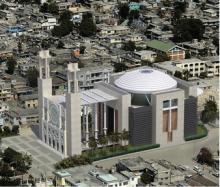
WE WERE LOOKING at cathedrals while others were mourning and burying their dead.
It was the first day of the international design competition that would help choose a few architectural plans that might be used to rebuild Notre Dame de l'Assomption, Our Lady of the Assumption, Port-au-Prince's most famous cathedral. This cathedral was so central to the city that, before it was leveled in the Jan. 12, 2010, earthquake, its turrets could be seen from most places in Port-au-Prince, as well as from the sea, where mariners used a light on the cupola of the church's north tower to help bring their ships home.
During the 2010 earthquake, the Catholic archbishop of Port-au-Prince, Monsignor Joseph Serge Miot, was killed inside an administrative building adjoining the cathedral, along with priests and parishioners. It was the images of their crushed bodies and their loved ones wailing around the perimeters of the cathedral's rubble that motivated me, a non-architect and non-Catholic—but a lover of cathedrals—to agree to join a development strategist, a preservationist architect, a structural engineer, a priest and liturgical consultant, the dean and associate dean of two architectural schools, and the editor of a magazine that discusses the dual issues of faith and architecture to help select three out of the 134 moving, elegant, and in some cases totally out-there designs that we had received from architects all over the world. Among the panelists, three of us were Haitian born, and many of the others had either worked in Haiti or in the Catholic Church for years.
The selection exercise itself was one that mirrored faith, blind faith. We were looking at sketches and plans but had no idea who had designed them. Some of the entries contained written statements that were so moving in their optimism for Port-au-Prince and its 3 million inhabitants, their hopes for Haiti and her people, and their longing for the rebuilt cathedral to serve as a symbol of renewal that they nearly brought me to tears.

IN THE EARLY weeks of the Eastertide lectionary, there appears a series of texts from the third and fourth chapters of Acts ... Peter and John, on their way to temple prayers, heal a man begging at the beautiful gate. His joy begets a sermon from Peter on the resurrection, at the close of which the disciples are arrested and spend the night in jail. The next day in court they again testify boldly, refuse to comply with the court's order, and are released after calculated threats from the authorities. Their release prompts prayers of thanksgiving in the community.
EACH DAY REV. JAMES BYENSI seeks the face of God in one of the world’s deadliest places, an environment where rape has been used as a weapon, children have had their innocence stolen, and the church of Jesus Christ is called to stand in the gap.
He lives in Bunia, a town on the eastern edge of the Democratic Republic of Congo (DRC). And while only the largest events of the DRC’s conflict—such as the M23 militia’s takeover of Goma, a city 300 miles south of Bunia—make world headlines, every day Byensi engages his community and country as an active agent of peace. For example, recently he helped deter a cycle of violence from escalating in his hometown. “Even as I write, I have just received a call from the mayor to join him in talking to a group of people who are protesting against the killing of their brother last night,” Byensi told Sojourners in October in one of several email interviews. “The killers were one of the rebel groups operating in the area surrounding Bunia.” While advocacy against violence is a cause close to Byensi’s heart, the protest itself threatened to become part of the problem: “Protest in this area is always violent and followed by looting or even rape,” he explained. The result of that meeting was that Byensi and the mayor together “devised the way to address the people and cool them down,” which included the mayor’s office helping the bereaved citizens with burial expenses.
That is the kind of advocacy and justice work Byensi does on a daily basis as a leadership and conflict-management consultant and trainer, and through the nonprofit he founded, the Rebuilders Ministry.
A VARIETY OF EVANGELICAL peacemaking efforts have sprung up in recent years, from the Two Futures Project, which seeks a world without nuclear weapons, to the World Evangelical Alliance’s Peace and Reconciliation Initiative, which seeks to redress the fact that “in our zeal for evangelism, we have often overlooked the biblical mandate to pursue peace.”
This fall, evangelicals from a range of viewpoints gathered at Georgetown University in Washington, D.C., exploring what a distinctive evangelical contribution to peacemaking might look like. The essays below, unless otherwise noted, are taken from the first Evangelicals for Peace conference, a “summit on Christian moral responsibility in the 21st century.” Organizers hope to publish a book with the entire collection of talks. —The Editors
-----
‘All the Easy Jobs Have Been Done’
Standing on a rich tradition of peace and transformation
by Geoff Tunnicliffe
WHY IS PEACEMAKING an important topic for evangelicals? As a global community of 600 million Christians, our churches are confronted daily with the impact of illegal weapons. Our hospitals treat the victims of violence. Our church leaders counsel the traumatized. All forms of conflict negatively impact our development programs. Our aid agencies seek to care for and rehabilitate child soldiers. Our inner-city communities are confronted with the outcomes of gang warfare.
For all of us who say we are followers of Jesus, as we observe or experience the brokenness of our world, it should break our hearts. If we feel the pain so deeply, I can’t imagine what our loving God feels. The One who is called the Prince of Peace. The One who laid down his life, so that we could be reconciled to God and each other.
The World Evangelical Alliance’s engagement in peacemaking stands on the rich traditions of evangelicals who have devoted themselves to being instruments of social change and transformation. We want to say loudly that we evangelicals want to be on the forefront of peacebuilding. All the easy jobs have been done. It’s just the tough ones that are left. It requires clear vision to face these challenges.
We as evangelicals are committed to working together with those in and outside our community for the good of all. May God empower us through the work of his Spirit to be his ambassadors of peace and reconciliation.

A new year evokes so many emotions in us. For some a wonder of potential opportunities. Others, the hope of change. Still others, the fear of uncertainty. In each case there lies a moment of suspense. A pause. And yet our resolutions are spoken, written and relayed far before the time has been taken to contemplate what we feel and how we feel.
This year my challenge is to start with the place of inaction and pause to consider what we in fact feel. To each of us we have to slow down after the Christmas season high of purchasing, giving, praying, lighting candles, waiting in Advent, and hoping for the Christ Child to know what kind of year we will encounter.
Resolve to be irresolute until the time of knowing appears.
Resolve to sit silent and listen.
Resolve to move slower until weary legs are refreshed.
Resolve to know loved ones as they are right now.
Resolve to build, to grow, to transform those parts that 2012 has damaged or left broken.
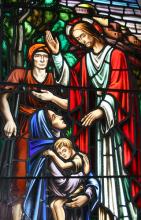
I've been thinking, as Advent goes on, what it meant for God to lay aside infinity and put on a body that was not just tiny, inarticulate, and helpless, but also already marked, to the marrow of its little bones, with the seeds of death.
He must have felt in his own flesh this dramatic comedown — from omnipotence and omnipresence to a being that had about threescore and 10, max, even if it hadn’t going to be cut off halfway by self-sacrifice and Roman capital punishment. And that must have given Jesus infinite tenderness and patience towards the waves and waves of people who, during his short ministry, were always coming up to him and asking, directly or just by their presence, for him to heal their bodies. In Luke, the Gospel focus of the new liturgical year, there are more than 20 healings by my count, compared to two times when someone asks Christ how to get eternal life (and only one of them actually wanted to know).
Those healings of all those bodies matter, millennia later. One big reason they matter is because healing matters. Another is because, by showing God's power over death as well as by going through death ahead of us, Christ teaches us not to be dominated by fear of it.

A TRADITIONAL whale-oil lamp is solemnly lit by an Inuit elder. After being brushed with cedar and smudged with sage, three commissioners take their seats. A survivor begins his testimony, haltingly narrating painful memories from 60 years ago. Soon tears begin to flow, and a support person carefully collects the tear-soaked tissues into a basket, to be added to the sacred fire that burns outside the hall. In this space, so filled with sorrow and rage, every ritual communicates respect, empathy, and determination, turning public halls into sanctuaries of healing.
For seven generations Indigenous Canadian children were taken from their homes and sent, most often by force, to Indian Residential Schools. Churches began operating these schools in the early 1860s, and by the 1890s the federal government had begun to make attendance mandatory as part of a policy of assimilation into Canadian society. In these schools children were forbidden to speak their native languages, forced to conform to European ways of life, and often abused emotionally, physically, and sexually. Though most residential schools were closed by the mid-1970s , the last was not shuttered until 1996.
As part of a 2007 legal settlement with survivors, the Truth and Reconciliation Commission of Canada (TRC) was created, with a five-year mandate to document the testimony of survivors, families, and communities affected by the residential school experience and to inform all Canadians about this tragic history. Launched in Winnipeg in June 2010, the TRC will include seven national and a number of regional hearings throughout the country. The hope is to “guide and inspire Aboriginal peoples and Canadians in a process of reconciliation and renewed relationships that are based on mutual understanding and respect.”